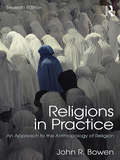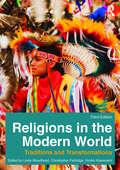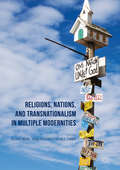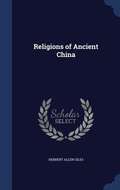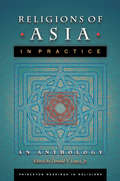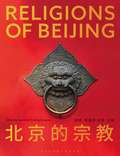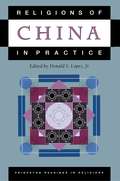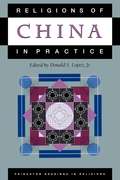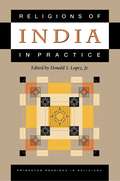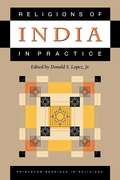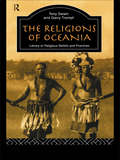- Table View
- List View
Religions in Practice: An Approach to the Anthropology of Religion
by John R. BowenReligions in Practice provides a comprehensive and primarily theme-based overview for students of the anthropology of religion. Whilst covering traditional topics such as magic, witchcraft, and spiritual healing, the book addresses key contemporary subjects including migration, transnationalism, nationalism, secularism, and law. It offers an issues-oriented perspective on everyday religious behaviors and examines small-scale societies as well as major, established religions. Throughout the text Bowen engages with ongoing debates concerning the place of religion in public life. He successfully balances the presentation of theory and concepts with rich case study examples, integrating theoretical discussion with a wide range of cross-cultural ethnographic material. This seventh edition has been updated throughout. The opening section now focuses more clearly on the question of what is ‘religion’ and on approaches to studying religion. There is more on materiality as well as a new final chapter on religious mobilizing and violence. Further resources are available via a comprehensive companion website.
Religions in the Modern World: Traditions and Transformations (2nd edition) (PDF)
by Hiroko Kawanami Christopher Partridge Linda WoodheadComprehensive in its coverage, this completely revised and updated second edition of Religions in the Modern World considers the history and modern practices of the world's main religious traditions. It analyses trends in the manifestation of religion in the modern world, from secularization to the rise of new spiritualities, and is at the cutting edge of developments in the study of religion. Religions in the Modern World is the ideal textbook for those coming to the study of religion for the first time, as well as for those who wish to keep up-to-date with the latest perspectives in the field. Fully international in coverage, it is accessibly written by practising and specialist teachers.
Religions in the Modern World: Traditions and Transformations
by Linda Woodhead Christopher Partridge Hiroko KawanamiReligions in the Modern World: Traditions and Transformations, Third Edition is the ideal textbook for those coming to the study of religion for the first time, as well as for those who wish to keep up-to-date with the latest perspectives in the field. This third edition contains new and upgraded pedagogic features, including chapter summaries, key terms and definitions, and questions for reflection and discussion. The first part of the book considers the history and modern practices of the main religious traditions of the world, while the second analyzes trends from secularization to the rise of new spiritualities. Comprehensive and fully international in coverage, it is accessibly written by practicing and specialist teachers.
Religions in the Modern World: Traditions and Transformations
by Linda Woodhead Christopher Partridge Hiroko KawanamiReligions in the Modern World: Traditions and Transformations, Third Edition is the ideal textbook for those coming to the study of religion for the first time, as well as for those who wish to keep up-to-date with the latest perspectives in the field. This third edition contains new and upgraded pedagogic features, including chapter summaries, key terms and definitions, and questions for reflection and discussion. The first part of the book considers the history and modern practices of the main religious traditions of the world, while the second analyzes trends from secularization to the rise of new spiritualities. Comprehensive and fully international in coverage, it is accessibly written by practicing and specialist teachers.
Religions, Nations, and Transnationalism in Multiple Modernities
by Bryan S. Turner Adam Possamai Patrick MichelThis edited book explores the impact of globalisation on the relationship between religion and politics, religion and nation, religion and nationalism, and the impact that transnationalism has on religious groups. In a post-Westphalian and transnational world, with increased international communication and transportation, a plethora of new religious recompositions religions now take part in a network society that cuts across borders. This collection, through its analysis of historical and contemporary case studies, explores the growth of both national and transnational religious movements and their dealings with the various versions of modernity that they encounter. It considers trends of religious revitalisation and secularisation, and processes of nationalism and transnationalism through the prism of the theory of multiple modernities, acknowledging both its pluralist world view but also the argument that its definition of modernity is often so inclusive as to lose coherence. Providing a cutting edge take on 21st century religion and globalization, this volume is a key read for all scholars of religion, secularisation and transnationalism.
Religions of Ancient China
by Herbert Allen GilesThis work has been selected by scholars as being culturally important, and is part of the knowledge base of civilization as we know it. This work was reproduced from the original artifact, and remains as true to the original work as possible. Therefore, you will see the original copyright references, library stamps (as most of these works have been housed in our most important libraries around the world), and other notations in the work. This work is in the public domain in the United States of America, and possibly other nations. Within the United States, you may freely copy and distribute this work, as no entity (individual or corporate) has a copyright on the body of the work. As a reproduction of a historical artifact, this work may contain missing or blurred pages, poor pictures, errant marks, etc. Scholars believe, and we concur, that this work is important enough to be preserved, reproduced, and made generally available to the public. We appreciate your support of the preservation process, and thank you for being an important part of keeping this knowledge alive and relevant.
Religions of Ancient India (Religious Studies: Bloomsbury Academic Collections)
by Louis RenouThis book is based on the inaugural Jordan Lecture Comparative Religion in 1951 and offers a survey of religious movements in India, past and present. Renou discusses the Veda, its rise and fall, and the state of studies of Vedic ritual, liturgy, mythology, magic, speculative thought, and secular discipline; the contribution of Vedic Upanishads to Hinduism; the Mahabharata; the expansion of Hinduism, its fertility and battle myths, eroticism, legends of the gods, cosmogonic speculations, and theories of transmigration and 'liberation'; its doctrine of meditation and exercises of Yoga; Hinduism's mosaic of sects and independent groups and their attitude to the caste system. The volume concludes with a presentation on Jainism, the ascetic, non-violent sect that has adapted to modern society.
Religions of Asia in Practice: An Anthology (Princeton Readings in Religions )
by Donald S. LopezThe acclaimed volumes of Princeton Readings in Religions present the remarkable range of all that is encompassed in the practice of religions, across the centuries and across the world. Religions of Asia in Practice: An Anthology brings together into a single volume the most important and fascinating selections from the volumes on Buddhism, India, China, Tibet, and Japan to give an overview of how religions have been lived by both ordinary and extraordinary people throughout the continent of Asia. These materials--many of which had never before been translated into any Western language--include ritual manuals, hagiographical and autobiographical writings, popular commentaries, instructions to children, poetry, and folktales. Each is preceded by a substantial introduction in which the translator discusses the text's history and influence and guides the reader through points of potential difficulty and particular interest. The volume includes, in addition, clear and compelling introductions to each of the major traditions. Religions of Asia in Practice: An Anthology offers a fascinating look at the spectrum of religious practices in Asia over almost three millennia. As such, it is ideally suited for use as a textbook in courses on world or Eastern religions as well as for the general reader.
Religions of Beijing
by Bob BlanchardReligions of Beijing offers an intimate portrayal of lived religion in 17 different religious communities in greater Beijing. Students at Minzu University of China spent one year immersed in the routine and practices daily, “writing with” the experiences and perspectives of their practitioners. Each chapter has been translated into English, with students at Drake University (Des Moines, Iowa) facilitating this process. The result is a bi-lingual book (Mandarin, English) that reveals to Chinese- and English-speaking readers the vibrant diversity of lived religion in contemporary Beijing.Each chapter focuses on the histories, practices, spaces, and members of its community, telling the overall story of the renewed flourishing of religion in Beijing. The book is also enriched with over 100 photos that portray this flourishing renewal, capturing the lived experience of ordinary practitioners. Together, the words and photographs of Religions of Beijing draw the reader into the stories and lives of these communities and their members, providing a first-hand look at the contemporary practice of religion in greater Beijing. The religions covered are Buddhism, Daoism, Confucianism, Protestantism, Catholicism, Islam and folk religion.Religions of Beijing is a collaboration of Minzu University of China and Drake University, USA.
Religions of Beijing
by Bob BlanchardReligions of Beijing offers an intimate portrayal of lived religion in 17 different religious communities in greater Beijing. Students at Minzu University of China spent one year immersed in the routine and practices daily, “writing with” the experiences and perspectives of their practitioners. Each chapter has been translated into English, with students at Drake University (Des Moines, Iowa) facilitating this process. The result is a bi-lingual book (Mandarin, English) that reveals to Chinese- and English-speaking readers the vibrant diversity of lived religion in contemporary Beijing.Each chapter focuses on the histories, practices, spaces, and members of its community, telling the overall story of the renewed flourishing of religion in Beijing. The book is also enriched with over 100 photos that portray this flourishing renewal, capturing the lived experience of ordinary practitioners. Together, the words and photographs of Religions of Beijing draw the reader into the stories and lives of these communities and their members, providing a first-hand look at the contemporary practice of religion in greater Beijing. The religions covered are Buddhism, Daoism, Confucianism, Protestantism, Catholicism, Islam and folk religion.Religions of Beijing is a collaboration of Minzu University of China and Drake University, USA.
Religions of China in Practice (Princeton Readings in Religions #37)
by Donald S. LopezThis third volume of Princeton Readings in Religions demonstrates that the "three religions" of China--Confucianism, Daoism, and Buddhism (with a fourth, folk religion, sometimes added)--are not mutually exclusive: they overlap and interact with each other in a rich variety of ways. The volume also illustrates some of the many interactions between Han culture and the cultures designated by the current government as "minorities." Selections from minority cultures here, for instance, are the folktale of Ny Dan the Manchu Shamaness and a funeral chant of the Yi nationality collected by local researchers in the early 1980s. Each of the forty unusual selections, from ancient oracle bones to stirring accounts of mystic visions, is preceded by a substantial introduction. As with the other volumes, most of the selections here have never been translated before. Stephen Teiser provides a general introduction in which the major themes and categories of the religions of China are analyzed. The book represents an attempt to move from one conception of the "Chinese spirit" to a picture of many spirits, including a Laozi who acquires magical powers and eventually ascends to heaven in broad daylight; the white-robed Guanyin, one of the most beloved Buddhist deities in China; and the burning-mouth hungry ghost. The book concludes with a section on "earthly conduct."
Religions of China in Practice
by Donald S. Lopez Jr.This third volume of Princeton Readings in Religions demonstrates that the "three religions" of China--Confucianism, Daoism, and Buddhism (with a fourth, folk religion, sometimes added)--are not mutually exclusive: they overlap and interact with each other in a rich variety of ways. The volume also illustrates some of the many interactions between Han culture and the cultures designated by the current government as "minorities." Selections from minority cultures here, for instance, are the folktale of Ny Dan the Manchu Shamaness and a funeral chant of the Yi nationality collected by local researchers in the early 1980s. Each of the forty unusual selections, from ancient oracle bones to stirring accounts of mystic visions, is preceded by a substantial introduction. As with the other volumes, most of the selections here have never been translated before. Stephen Teiser provides a general introduction in which the major themes and categories of the religions of China are analyzed. The book represents an attempt to move from one conception of the "Chinese spirit" to a picture of many spirits, including a Laozi who acquires magical powers and eventually ascends to heaven in broad daylight; the white-robed Guanyin, one of the most beloved Buddhist deities in China; and the burning-mouth hungry ghost. The book concludes with a section on "earthly conduct."
Religions of India: An Introduction
by Sushil Mittal Gene ThursbyIndia is a highly diverse country, home to a wide array of languages, religions, and cultural traditions. Analyzing the dynamic religious traditions of this democratic nation sheds light on the complex evolution from India’s past to today’s modern culture. Written by leading experts in the field, Religions of India provides students with an introduction to India’s vibrant religious faiths. To understand its heritage and core values, the beginning chapters introduce the indigenous Dharmic traditions of Hinduism, Jainism, Buddhism, and Sikhism, while the later chapters examine the outside influences of Zoroastrianism, Judaism, Christianity, and Islam. These chapters are designed for cross-religious comparison, with the history, practices, values, and worldviews of each belief system explained. The final chapter helps students relate what they have learnt to religious theory, preparing the way for future study. This thoroughly revised second edition combines solid scholarship with clear and lively writing to provide students with an accessible and comprehensive introduction to religion in India. This is the ideal textbook for students approaching religion in Asia, South Asia, or India for the first time. Features to aid study include: discussion questions at the end of each chapter, images, a glossary, suggestions for further reading, and an Companion Website with additional links for students to further their study.
Religions of India: An Introduction
by Sushil Mittal Gene ThursbyIndia is a highly diverse country, home to a wide array of languages, religions, and cultural traditions. Analyzing the dynamic religious traditions of this democratic nation sheds light on the complex evolution from India’s past to today’s modern culture. Written by leading experts in the field, Religions of India provides students with an introduction to India’s vibrant religious faiths. To understand its heritage and core values, the beginning chapters introduce the indigenous Dharmic traditions of Hinduism, Jainism, Buddhism, and Sikhism, while the later chapters examine the outside influences of Zoroastrianism, Judaism, Christianity, and Islam. These chapters are designed for cross-religious comparison, with the history, practices, values, and worldviews of each belief system explained. The final chapter helps students relate what they have learnt to religious theory, preparing the way for future study. This thoroughly revised second edition combines solid scholarship with clear and lively writing to provide students with an accessible and comprehensive introduction to religion in India. This is the ideal textbook for students approaching religion in Asia, South Asia, or India for the first time. Features to aid study include: discussion questions at the end of each chapter, images, a glossary, suggestions for further reading, and an Companion Website with additional links for students to further their study.
Religions of India in Practice (Princeton Readings in Religions)
by Donald S. LopezThe inaugural volume of Princeton Readings in Religions brings together the work of thirty scholars of the religions of India in a new anthology designed to reshape the ways in which the religious traditions of India are understood. The book contains translations of forty-five works, most of which have never before been available in a Western language. Many of these highlight types of discourse (especially ritual manuals, folktales, and oral narratives) and voices (vernacular, esoteric, domestic, and female) that have not been sufficiently represented in previous anthologies and standard accounts of Indian religions. The selections are drawn from ancient texts, medieval manuscripts, modern pamphlets, and contemporary fieldwork in rural and urban India. They represent every region in South Asia and include Hindu, Buddhist, Jain, Sikh, and Muslim materials. Some are written texts reflecting elite concerns, while others are transcriptions of oral narratives told by nonliterate peasants. Some texts are addressed to a public and pan-Indian audience, others to a limited coterie of initiates in an esoteric sect, and still others are intended for a few women gathered in the courtyard for a household ceremony. The editor has reinforced this diversity by arranging the selections within several overarching themes and categories of discourse (hymns, rituals, narratives, and religious interactions), and encourages us to make our own connections.
Religions of India in Practice
by Donald S. Lopez Jr.The inaugural volume of Princeton Readings in Religions brings together the work of thirty scholars of the religions of India in a new anthology designed to reshape the ways in which the religious traditions of India are understood. The book contains translations of forty-five works, most of which have never before been available in a Western language. Many of these highlight types of discourse (especially ritual manuals, folktales, and oral narratives) and voices (vernacular, esoteric, domestic, and female) that have not been sufficiently represented in previous anthologies and standard accounts of Indian religions. The selections are drawn from ancient texts, medieval manuscripts, modern pamphlets, and contemporary fieldwork in rural and urban India. They represent every region in South Asia and include Hindu, Buddhist, Jain, Sikh, and Muslim materials. Some are written texts reflecting elite concerns, while others are transcriptions of oral narratives told by nonliterate peasants. Some texts are addressed to a public and pan-Indian audience, others to a limited coterie of initiates in an esoteric sect, and still others are intended for a few women gathered in the courtyard for a household ceremony. The editor has reinforced this diversity by arranging the selections within several overarching themes and categories of discourse (hymns, rituals, narratives, and religious interactions), and encourages us to make our own connections.
Religions of Japan in Practice (Princeton Readings in Religions #8)
by George J. TanabeThis anthology reflects a range of Japanese religions in their complex, sometimes conflicting, diversity. In the tradition of the Princeton Readings in Religions series, the collection presents documents (legends and miracle tales, hagiographies, ritual prayers and ceremonies, sermons, reform treatises, doctrinal tracts, historical and ethnographic writings), most of which have been translated for the first time here, that serve to illuminate the mosaic of Japanese religions in practice. George Tanabe provides a lucid introduction to the "patterned confusion" of Japan's religious practices. He has ordered the anthology's forty-five readings under the categories of "Ethical Practices," "Ritual Practices," and "Institutional Practices," moving beyond the traditional classifications of chronology, religious traditions (Shinto, Confucianism, Buddhism, etc.), and sects, and illuminating the actual orientation of people who engage in religious practices. Within the anthology's three broad categories, subdivisions address the topics of social values, clerical and lay precepts, gods, spirits, rituals of realization, faith, court and emperor, sectarian founders, wizards, and heroes, orthopraxis and orthodoxy, and special places. Dating from the eighth through the twentieth centuries, the documents are revealed to be open to various and evolving interpretations, their meanings dependent not only on how they are placed in context but also on how individual researchers read them. Each text is preceded by an introductory explanation of the text's essence, written by its translator. Instructors and students will find these explications useful starting points for their encounters with the varied worlds of practice within which the texts interact with readers and changing contexts. Religions of Japan in Practice is a compendium of relationships between great minds and ordinary people, abstruse theories and mundane acts, natural and supernatural powers, altruism and self-interest, disappointment and hope, quiescence and war. It is an indispensable sourcebook for scholars, students, and general readers seeking engagement with the fertile "ordered disorder" of religious practice in Japan.
Religions of Japan in Practice
by George J. Tanabe Jr.This anthology reflects a range of Japanese religions in their complex, sometimes conflicting, diversity. In the tradition of the Princeton Readings in Religions series, the collection presents documents (legends and miracle tales, hagiographies, ritual prayers and ceremonies, sermons, reform treatises, doctrinal tracts, historical and ethnographic writings), most of which have been translated for the first time here, that serve to illuminate the mosaic of Japanese religions in practice. George Tanabe provides a lucid introduction to the "patterned confusion" of Japan's religious practices. He has ordered the anthology's forty-five readings under the categories of "Ethical Practices," "Ritual Practices," and "Institutional Practices," moving beyond the traditional classifications of chronology, religious traditions (Shinto, Confucianism, Buddhism, etc.), and sects, and illuminating the actual orientation of people who engage in religious practices. Within the anthology's three broad categories, subdivisions address the topics of social values, clerical and lay precepts, gods, spirits, rituals of realization, faith, court and emperor, sectarian founders, wizards, and heroes, orthopraxis and orthodoxy, and special places. Dating from the eighth through the twentieth centuries, the documents are revealed to be open to various and evolving interpretations, their meanings dependent not only on how they are placed in context but also on how individual researchers read them. Each text is preceded by an introductory explanation of the text's essence, written by its translator. Instructors and students will find these explications useful starting points for their encounters with the varied worlds of practice within which the texts interact with readers and changing contexts. Religions of Japan in Practice is a compendium of relationships between great minds and ordinary people, abstruse theories and mundane acts, natural and supernatural powers, altruism and self-interest, disappointment and hope, quiescence and war. It is an indispensable sourcebook for scholars, students, and general readers seeking engagement with the fertile "ordered disorder" of religious practice in Japan.
Religions of Korea in Practice (Princeton Readings in Religions )
by Robert E. BuswellKorea has one of the most diverse religious cultures in the world today, with a range and breadth of religious practice virtually unrivaled by any other country. This volume in the Princeton Readings in Religions series is the first anthology in any language, including Korean, to bring together a comprehensive set of original sources covering the whole gamut of religious practice in both premodern and contemporary Korea. The book's thirty-two chapters help redress the dearth of source materials on Korean religions in Western languages. Coverage includes shamanic rituals for the dead and songs to quiet fussy newborns; Buddhist meditative practices and exorcisms; Confucian geomancy and ancestor rites; contemporary Catholic liturgy; Protestant devotional practices; internal alchemy training in new Korean religions; and North Korean Juche ("self-reliance") ideology, an amalgam of Marxism and Neo-Confucian filial piety focused on worship of the "father," Kim Il Sung. Religions of Korea in Practice provides substantial coverage of contemporary Korean religious practice, especially the various Christian denominations and new indigenous religions. Each chapter includes an extensive translation of original sources on Korean religious practice, accompanied by an introduction that frames the significance of the selections and offers suggestions for further reading. This book will help any reader gain a better appreciation of the rich complexity of Korea's religious culture.
Religions of Late Antiquity in Practice
by Richard ValantasisThis is an unprecedented collection of nearly seventy Late Antique primary religious texts. These texts--all in new English translation and many appearing in English for the first time--represent every major religious current from the late first century until the rise of Islam. Produced through the efforts of thirty-six leading scholars in the field, they constitute a comprehensive view of religious practice in Late Antiquity. Religious life and performance during this period comprised diverse, often unusual practices. Philosophical ascent, magic, legal pronouncement, hymnography, dietary and sexual restriction, and rhetoric were all part of this deeply fascinating world. Religious and political identity often intertwined, as reflected in the Roman persecution of Christians. And a fluid boundary between religion and superstition was contested in daily life. Many practices, including ascetic training, crossed religious boundaries. Others, such as "incubation" at specific temples and certain divination rites, were distinctive practices of individual groups and orders. Intrinsically interesting, the practice of religion in the Late Antique also edifies modern-day religious life. As this volume shows, the origins of the contemporary Western religious terrain can be gleaned in this period. Rabbinic Judaism flourished and spread. Christianity developed still-important theological categories and structures. And even movements that did not survive intact--such as Neoplatonism and the once-powerful Manichaean churches--continue to influence religion today. This rich sourcebook includes discussions of asceticism, religious organization, ritual, martyrdom, religion's social implications, law, and theology. Its unique emphasis on practice and its inclusion of texts translated from lesser-known languages advance the study of religious history in several directions. A strong interdisciplinary orientation will reward scholars and students of religion, theology, gender studies, classical literatures, and history. Each text is accompanied by an introduction and a bibliography for further reading and research, making the book appropriate for use in any university or seminary classroom.
Religions of Late Antiquity in Practice (Princeton Readings in Religions )
by Richard ValantasisThis is an unprecedented collection of nearly seventy Late Antique primary religious texts. These texts--all in new English translation and many appearing in English for the first time--represent every major religious current from the late first century until the rise of Islam. Produced through the efforts of thirty-six leading scholars in the field, they constitute a comprehensive view of religious practice in Late Antiquity. Religious life and performance during this period comprised diverse, often unusual practices. Philosophical ascent, magic, legal pronouncement, hymnography, dietary and sexual restriction, and rhetoric were all part of this deeply fascinating world. Religious and political identity often intertwined, as reflected in the Roman persecution of Christians. And a fluid boundary between religion and superstition was contested in daily life. Many practices, including ascetic training, crossed religious boundaries. Others, such as "incubation" at specific temples and certain divination rites, were distinctive practices of individual groups and orders. Intrinsically interesting, the practice of religion in the Late Antique also edifies modern-day religious life. As this volume shows, the origins of the contemporary Western religious terrain can be gleaned in this period. Rabbinic Judaism flourished and spread. Christianity developed still-important theological categories and structures. And even movements that did not survive intact--such as Neoplatonism and the once-powerful Manichaean churches--continue to influence religion today. This rich sourcebook includes discussions of asceticism, religious organization, ritual, martyrdom, religion's social implications, law, and theology. Its unique emphasis on practice and its inclusion of texts translated from lesser-known languages advance the study of religious history in several directions. A strong interdisciplinary orientation will reward scholars and students of religion, theology, gender studies, classical literatures, and history. Each text is accompanied by an introduction and a bibliography for further reading and research, making the book appropriate for use in any university or seminary classroom.
Religions of Melanesia: A Bibliographic Survey (Bibliographies and Indexes in Religious Studies)
by Garry TrompfMelansia boasts over one-quarter of the world's distinct religions and presents the most complex religious panorama on earth. The region is famous for its unusual new religious movements that have adapted traditional beliefs to modernity in surprising ways. As the first bibliographical survey to comprehensively cover the entire region, Religions of Melanesia is an invaluable research aid for anyone interested in this growing field. Trompf's work is a complete listing of scholarly publications and provides readable and concise descriptions that will clearly guide the researcher toward the most relevant sources.This survey covers 2188 entries organized topically and regionally. Trompf covers such subjects as traditional and modern belief systems and the emergent indigenous Christianity that has taken root. Regional coverage includes Irian Jaya, Papua New Guinea, Solomon Islands, Vanuatu, New Caledonia, and Fiji.
The Religions of Oceania
by Garry TrompfMore than a quarter of the world's religions are to be found in the regions of Australia, Melanesia, Micronesia and Polynesia, together called Oceania. The Religions of Oceania is the first book to bring together up-to-date information on the great and changing variety of traditional religions in the Pacific zone. The book also deals with indigenous Christianity and its wide influence across the region, and includes new religious movements generated by the responses of indigenous peoples to colonists and missionaries, the best known of these being the `Cargo Cults' of Melanesia. The authors present a thorough and accessible examination of the fascinating diversity of religious practices in the area, analysing new religious developments, and provideing clear interpretative tools and a mine of information to help the student better understand the world's most complex ethnologic tapestry.
The Religions of Oceania (The Library of Religious Beliefs and Practices)
by Garry TrompfMore than a quarter of the world's religions are to be found in the regions of Australia, Melanesia, Micronesia and Polynesia, together called Oceania. The Religions of Oceania is the first book to bring together up-to-date information on the great and changing variety of traditional religions in the Pacific zone. The book also deals with indigenous Christianity and its wide influence across the region, and includes new religious movements generated by the responses of indigenous peoples to colonists and missionaries, the best known of these being the `Cargo Cults' of Melanesia. The authors present a thorough and accessible examination of the fascinating diversity of religious practices in the area, analysing new religious developments, and provideing clear interpretative tools and a mine of information to help the student better understand the world's most complex ethnologic tapestry.
Religions of South Asia: An Introduction
by Sushil Mittal Gene ThursbySouth Asia is home to many of the world's most vibrant religious faiths. It is also one of the most dynamic and historically rich regions on earth, where changing political and social structures have caused religions to interact and hybridise in unique ways. This textbook introduces the contemporary religions of South Asia, from the indigenous religions such as the Hindu, Jain, Buddhist and Sikh traditions, to incoming influences such as Christianity, Judaism and Islam. In ten chapters, it surveys the nine leading belief systems of South Asia and explains their history, practices, values and worldviews. A final chapter helps students relate what they have learnt to religious theory, paving the way for future study. Written by leading experts, Religions of South Asia combines solid scholarship with clear and lively writing to provide students with an accessible and comprehensive introduction. All chapters are specially designed to aid cross-religious comparison, following a standard format covering set topics and issues; the book reveals to students the core principles of each faith, compares it to neighbouring traditions, and its particular place in South Asian history and society. It is a perfect resource for all students of South Asia's diverse and fascinating faiths.
